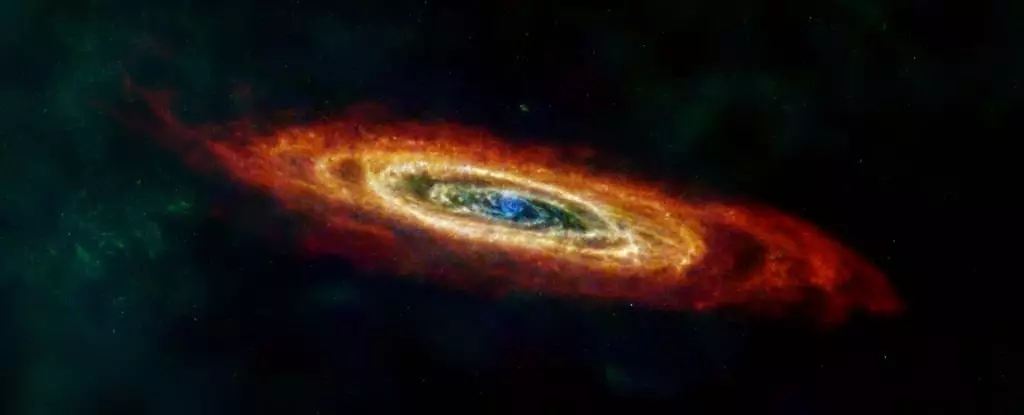In the grand tapestry of cosmic phenomena, few events capture the imagination quite like the explosion of a massive star—a supernova. These awe-inspiring explosions, typically occurring in stars that are at least eight times more massive than our Sun, are a dazzling spectacle of energy. Yet, recent astronomical discoveries reveal a different narrative: not all massive stars end their lives in catastrophic bursts. Some appear to bypass the supernova stage entirely, leading to the formation of black holes. This article delves into the implications of these findings, focusing on the intriguing case of a massive star located in the Andromeda galaxy that defied expectations by collapsing directly into a black hole.
Supernovae occur at the conclusion of a star’s life when it exhausts its nuclear fuel, particularly hydrogen. The balance between the outward pressure from nuclear fusion and the inward pull of gravity becomes destabilized, leading to the star’s core collapsing. This collapse triggers a cascade of reactions, resulting in a spectacular explosion that often outshines entire galaxies. These cosmic events are classified as core-collapse supernovae (Type II), which are essential for understanding the synthesis of heavier elements in the universe. They also play a critical role in star formation and generate cosmic rays that permeate our galaxy.
However, new research sheds light on an unsettling reality within this well-established framework: some massive stars might not explode at all. This article spotlights the research defining one such case within the Andromeda galaxy, designated M31-2014-DS1.
The star M31-2014-DS1 has captured the attention of the astronomical community due to its peculiar behavior observed between 2014 and 2019. Initially, astronomers detected an increase in brightness, followed by a plateau in luminosity for approximately one thousand days. After this period, a dramatic fade occurred over the next thousand days. This behavior raised flags among researchers, particularly as no optical outburst—typically associated with supernova events—was present.
The research team led by Kishalay De from the Kavli Institute for Astrophysics and Space Research at MIT posits that this massive star, initially around 20 solar masses, experienced a radical reduction in mass, leaving it to weigh approximately 6.7 solar masses by the end of its nuclear burning phase. The team’s observations suggest that a fresh dust shell enveloped the star, hinting at a traditional supernova, yet the absence of a luminous explosion suggests something entirely different.
The realization that a massive star can transition directly into a black hole without undergoing a conventional supernova challenges long-standing astronomical assumptions. The transition involves a complex interplay of forces and materials within the star’s core. In a typical supernova, the core’s density escalates, leading to a process known as neutronization, where electrons merge with protons to produce neutrons and neutrinos. This results in a neutrino shock wave that can fuel the explosive outburst. However, when this shock wave does not revive, the core collapses inward, birthing a black hole.
In the case of M31-2014-DS1, researchers determined that the neutrino shock failed to gain momentum, creating a scenario where approximately 98% of the star’s mass ultimately collapsed into its core rather than exploding outward. Consequently, the formation of a black hole with approximately 6.5 solar masses ensued. This phenomenon opens up tantalizing questions about the fate of similar stars that elude the watchful eye of astronomers.
The discovery of M31-2014-DS1 adds to a growing list of candidates for failed supernovae—a category that remains elusive, as these events often lack the dramatic indicators typical of supernovae. While astronomers have pinpointed the confirmed case of another star, N6946-BH1 in the “Fireworks Galaxy,” it is apparent that the cosmic landscape may inherently harbor more mysteries than we have begun to uncover.
Estimates suggest that between 20% to 30% of massive stars may meet a fate similar to M31-2014-DS1, transforming silently into black holes rather than exploding into brilliant supernovae. This raises profound implications for our understanding of stellar evolution, the chemical enrichment of the universe, and the dynamics of cosmic ray generation. The findings invite scientists to reassess their models of stellar lifecycle and evolution.
As astronomers continue to grapple with the complexities of stellar fates, the case of M31-2014-DS1 serves as a reminder of the vast unknowns that still linger in the cosmic arena. The possibility of failed supernovae alters our perception of how stars interact with their environments and contributes to the intricate mechanism of the universe’s evolution. With advanced observational techniques and increased interest in the phenomena surrounding massive stars, the future holds promise for further breakthroughs that rewrite our understanding of the cosmos. The exploration of these mysterious events not only enriches our knowledge of starliness but also deepens our appreciation for the complexity and dynamism inherent in the universe.


Leave a Reply